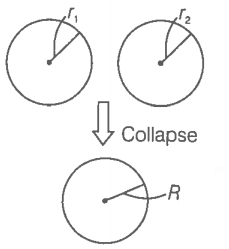Hint: The energy released will be equal to the change in surface energy.
Step 1: Find the change in surface area.
Consider the diagram.
Radii of mercury droplets,
r1=0.1 cm=1×10-3mr1=0.1 cm=1×10−3m
r2=0.2 cm=2×10-3mr2=0.2 cm=2×10−3m
Surface tension, (T) = 435.5 x10-310−3N/m
Let the radius of the big drop formed by collapsing be R.
∴∴The volume of big drop=Volume of small droplets
43πR3=43πr31+43πr2243πR3=43πr31+43πr22
or R3=r31+r32R3=r31+r32
=(0.1)3+(0.2)3 =0.001+0.008 =(0.1)3+(0.2)3 =0.001+0.008
=0.009 =0.009
or R = 0.21 cm=2.1×10-3m0.21 cm=2.1×10−3m
∴∴Change in surface area,
∆A=4πR2-(4πr21+4πr22)ΔA=4πR2−(4πr21+4πr22)
=4π[R2-(r21+r22)] =4π[R2−(r21+r22)]
Step 2: Find the change in surface energy.
∴∴ The energy released =T. ∆A=T. ΔA (where T is the surface tension of mercury)
=435.5×10-3×4×3.14×[(2.1×10-3)2-(1×10-3)2-(2×10-3)2]=-3.22×10-6 J
(The negative sign shows absorption)
Therefore, 3.22×10-6 J energy will be absorbed.


